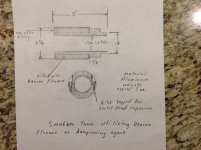Consider this. The vibrations travel in steel at around 19000 fps which is considerably faster than the bullet. For a .001 tuner change to affect the angular muzzle position at the moment of the bullet exit, the wavelength of such a vibration would be very short and as such is a very high frequency. This frequency is way above 20000 hz. The wavelength of 2.4mhz I believe, is around .001. Since there are 6 points in a single complete waveform that one might tune at, the actual critical frequency might be about 1.2 mhz. Most of the frequencies normally referred to regarding barrel vibrations are too low and slow to set up before the bullet is long gone. They only start to move, hence just putting weight on the end reduces their effect. To detect and analyse this would require extremely sensitive and expensive equipment and expertise. Only somebody such as DARPA would fund such research if they were interested. As to what may be the excitation for such a high frequency, I would guess it is the priming compound explosion, since it is by far, the fastest thing moving in a firearm.
Jerry, I think this makes sense.
Gene, I've found that moving my tuner inward as temps rise is what works for me. As you know, I'm being very methodical with my testing of tuner movement and its effect...so I don't think I'm missing or turning past a node.
Admittedly, I can't get my head around your statement that the frequency got higher as you moved the tuner out. Perhaps I'm missing something, and must be, for this to factually be the case. There is still plenty of room to learn, above and beyond what electronic vibration analysis testing I have had done. I hope to be able to further that testing at some point. That said, what you claim in this regard is not what I've seen. Please keep in mind that I'm not saying that it is incorrect, but just that it is counter to what I've been able to conclude..so far, and seems to be counter to what little I do know about this subject. I don't know what else to say in this regard, at this point. Perhaps we are focusing too much on external factors when it may be that internal ballistics are what really drive this subject.
Either way, IME, what Boyd said seems to be the case...We are timing bullet exit with muzzle position. I don't agree with him that turning the tuner in either direction can only improve tune unless the gun is in a state of being "completely" out of tune. In use, this is virtually never the case unless just starting out with a tuner for the first time. IME, typical "practical" tuner movement is about half of it's total effect on tune. I've never seen tune affected by conditions by as much as a tuner is capable of affecting the tune. IOW, I've never seen the gun out of tune enough to use the full range of tuner movement needed to take it from completely in tune to completely out of tune, in a match or otherwise...only during initial tuner setting.
Regardless, while we'd like to understand the why's and what for's better, it remains very true that tuner usage is far and away simpler than understanding how they do what they do. One only needs a tuner and a good rifle..along with about 15 minutes of good conditions to prove that much.
Carry on, please. I'm certainly enjoying reading this and your findings. I'm most certainly keeping an open mind to what you say. Hopefully, we'll get to the bottom of this...or our grand kids will.--Mike


